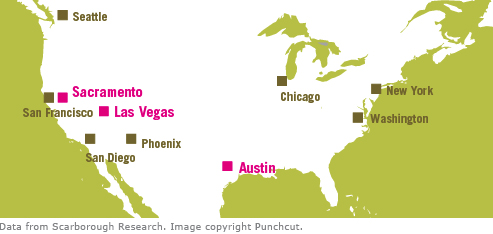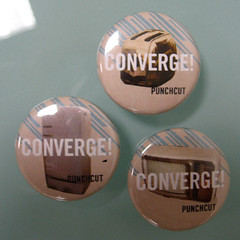 One of the tenets of modern convergence, or at least our version of it, is that portability of content — across sites, portable devices and applications — is paramount. The usefulness of all that personal information, user generated content and contacts can expand and create new or enhanced services when more of those services open themselves up.
One of the tenets of modern convergence, or at least our version of it, is that portability of content — across sites, portable devices and applications — is paramount. The usefulness of all that personal information, user generated content and contacts can expand and create new or enhanced services when more of those services open themselves up.
Getting these services (sites) to talk nicely, and securely, to each other is where OAuth comes in. OAuth — the “open authorization” API standard — is essentially a push for the portability of digital content. The effort made headlines because a group of influential parties, Yahoo, Google, AOL, Twitter, Ma.gnolia, Citizen Agency, Wesabe, Pownce and Six Apart have signed an agreement not to sue.
The nuances get a bit technical, but ReadWriteWeb has a good primer on OAuth and a layman’s overview of today’s news.
The upshot is we’ll see more mashups (think Google Reader + Craigslist + Flickr) which is a step in the right direction for content portability across devices and services.
Add this to digg, del.icio.us, etc.

If you were asked to list the top US “early adopter” cities you might start in Silicon Valley. Nope. Austin tops the list, then Las Vegas and Sacramento followed by San Diego, Washington DC, Seattle, Phoenix, Chicago, New York and San Francisco.
The Scarborough report is a free 70 page report that aims to hone in on the “digital savvy” of the US population. The report has narrowed these people down to a small 6% of Americans who have adopted certain digital behaviors — they have DVRs, MP3 players, HDTV; they are likely to use VOD, VOIP and more advanced mobile device features. The report busts assumptions that early adopters are all MySpace users (they’re more likely to read ESPN.com and CNN.com). Download the report for the full demographic analysis.
Add this to digg, del.icio.us, etc.
 Convergence is sometimes viewed as the consolidation of multiple technologies towards a singular über-device. I prefer to view convergence as the tendency of technologies, as they grow in complexity and scope, to overlap and consolidate functions. Convergence is a trend wherein devices and functions take on commonly shared traits, but this doesn’t mean that this trend ultimately ends with a single, multi-functional mega-device, no matter how cool and ‘mad scientist’ that might sound. Product mobility, technical innovation, component obsolescence, and proprietary ownership of certain functions are among the many forces that will ensure we continue to interact with ecosystems of related and overlapping devices rather than a single device with every function built in.
Convergence is sometimes viewed as the consolidation of multiple technologies towards a singular über-device. I prefer to view convergence as the tendency of technologies, as they grow in complexity and scope, to overlap and consolidate functions. Convergence is a trend wherein devices and functions take on commonly shared traits, but this doesn’t mean that this trend ultimately ends with a single, multi-functional mega-device, no matter how cool and ‘mad scientist’ that might sound. Product mobility, technical innovation, component obsolescence, and proprietary ownership of certain functions are among the many forces that will ensure we continue to interact with ecosystems of related and overlapping devices rather than a single device with every function built in.
But, convergence as a concept illustrates how interaction design for devices is changing. As our devices advance, they are often consolidating functions previously reserved for separate devices. Examples of this can be seen in most modern devices, from mobile phones (which serve as PDAs, calculators, mini-computers, and portable game consoles as well as communication devices) to Media Center PCs (which serve as DVR, stereo music player, and digital picture frame as well as a standard personal computer).
With all this in mind, I’m offering up 7 considerations to use when designing interactions for converged devices.
Continue Reading »
Add this to digg, del.icio.us, etc.
This iPhone tip goes out to those of you following the growing “Life Hacks” movement - gaining back precious minutes of your life through efficiency practices.
We’ve all been stuck in meetings that we wish we could get out of. Well, fortunately His Steveness has designed something handy into the iPhone which will help us reclaim our lives so we can get back to doing what we _really_ want to be doing. If you have the foresight, try this before attending your next meeting:From the main menu, select Clock then Timer. Use the wheel interface to set your interval (How much of this meeting are you willing to endure?), set your ringtone and hit “Start.”
Attend your meeting. Go ahead and shut your phone down (read as: Hit the hardware button on top right) and set it on the table next to your notebook, printouts, etc. and act as interested as you can in the meeting. Resist the urge to check the timer - don’t worry, it won’t let you down. When the timer reaches zero, it will wake up your iPhone and play the ringtone. To anyone glancing over at your iPhone, the combination of idle screen wallpaper and ringtone will look convincing, even to a fellow iPhone user.
Grab it shortly into the first ring, give it a quick glance, and apologize to those left in the room.. “Sorry, I gotta take this…”
Add this to digg, del.icio.us, etc.

This month, Google Labs released a new service called GOOG-411. A toll-free call will get you in touch with a friendly, natural-sounding robot asking you for your city, your listing or category, and then offer to connect you, give you address details, or send all those goodies to your phone via text message. The voice recognition is impressive and the overall flow is fairly speedy, though there are certainly redundancies that lengthen the overall process for the sake of usability (which in this case earns them points in my book). Luckily, there’s a cheat sheet for advanced users to blast past some of the menus.
GOOG-411 is a clever development effort on Google’s part as all of this infrastructure — maps, text messaging, business directory search — is already part of the Google suite of services and this mashup recipe sets them up with a solid core experience. Building on this service is only a matter of choosing which pieces will add to the user experience and not overly complicate its current simplicity. For example, I can easily imagine saying “Directions” and having step-by-step instructions of how to get there from where I am while leveraging my phone’s location data.
Continue Reading »
Add this to digg, del.icio.us, etc.
If you think Tamagotchi is past tense for virtual pet, think again. They’re connecting with some US partners to create a competitor to Disney Mobile and Firefly.
“Tamagotchi virtual pet now comes as just one of the many features loaded onto a fully functional prepaid mobile phone for kids. The phone is being brought to retail through a joint effort between PlayPhone and Bandai America Inc.�?
Summary:
- It’s aimed at kids, duh

- The handset is brightly colored and comes with a preloaded Tamagotchi mobile game and a custom Tamagotchi wallpaper
- It’s a no-contract, pay-as-you-go handset
- It comes with parental controls that parents will be able to limit dialing access for incoming and outgoing calls and lock the push-to-talk and Web access capabilities.
- Ability to convert users’ prepaid airtime minutes into mobile content credits to spend on additional wallpapers, games, and Ringtones on the TamaPhone.com Website – thus avoiding the use of a credit card.
Read more information at: http://www.collectiondx.com/node/147
Add this to digg, del.icio.us, etc.

EMI keynote at CTIA Orlando
Eric Nicoli (CEO of EMI Group) hinted in his keynote at CTIA that his company had been “experimenting” with DRM-free music and said that their studies showed people would be willing to pay more for it. Last weeks’EMI Group announcement of an iTunes deal will make higher quality, DRM-free, tunes available for $1.29. The new offering doesn’t replace the existing $.99 DRM versions. What’s even more user-friendly is that users who own DRM versions can upgrade their tracks for $.30 each.
 Eric Nicoli also made a call for the mobile industry, specifically those in the media and entertainment realm, to take cues from Apple and address issues like value for price, making compelling products and ease of use.
Eric Nicoli also made a call for the mobile industry, specifically those in the media and entertainment realm, to take cues from Apple and address issues like value for price, making compelling products and ease of use.
Add this to digg, del.icio.us, etc.
This is no April Fool’s joke. “New Bar Codes Can Talk With Your Phone�? is the New York Times write-up of the emerging trend.
From the article:
“In Japan, McDonald’s customers can already point their cellphones at the wrapping on their hamburgers and get nutrition information on their screens. Users there can also point their phones at magazine ads to receive insurance quotes, and board airplanes using their phones rather than paper tickets. And film promoters can send their movie trailers from billboards.”
Clearly the US has a way to go before catching on. Mainstream media just may be catching on too:
“The cellphone is the natural tool to combine the physical world with the digital world,�?
Related resources:
1. “China: Craking the Mobile Ad Biz�? – An article from BusinessWeek focusing on mobile barcodes in China
2. “All About Mobile Life�? - A blog focusing on Kaywa QR code, a barcode service in Switzerland offering a bridge between We-based and Mobile content.
Add this to digg, del.icio.us, etc.
New technologies create new contexts of use. So when the folks behind Odeo invented Twitter, my new context-of-use became receiving and managing dozens of text messages a day while friends constantly update their statuses.
I want to stay connected to my friends, but do I need to know every minute detail of each of their days ad nauseum? It reminds me of the dawn of blogs, where fledgling bloggers felt their lives were so important that everyone needed to know what they had for breakfast.
Let’s look at Instant Messenger. At a glance, I can immediately see who’s available and who’s not available by the colored dot next to their name. If my friends decide that the world needs to know more about their day, they have the option to include an optional status message.
Updating your status is relatively quick and easy. With one click, I can pick from a list of status messages I’ve created and my status is quietly updated across those buddy lists in which I appear.
Note: Quietly.
Continue Reading »
Add this to digg, del.icio.us, etc.
iPods sold at a brisk pace over the 2006 holiday season, which would seem to end the recent iPod sales slump. However, Tomi Ahonen aims to blow away any speculation that the iPod is still holding on to the music player throne. The barrage of evidence from Asian, European and UK studies he presents is pretty compelling. In a nutshell, he says that while iPod sales grew 45% that music phone growth has boomed to 243%, which means that though iPod sales are growing, the iPod market share has been long overtaken by music phones and is shrinking by comparison. (SonyEricsson alone shipped 60 million musicphones compared to Apple’s 46 million iPods).
Now, you’re thinking, “but just because people own a music-capable phone, a so called music phone, do people actually use them for listening/buying music?” Well, Ahonen says yes, and backs it up with some interesting European and Asian studies. The UK study he sites says that 80% of musicphone owners are satisfied or very satisfied with them. Thus Ahonen’s argument goes: the iPod is so totally over.
He’s quick to dismiss the iPod and usher in the music phone era, but I don’t think he’s really discussing the US side of the picture…
Continue Reading »
Add this to digg, del.icio.us, etc.
 One of the tenets of modern convergence, or at least our version of it, is that portability of content — across sites, portable devices and applications — is paramount. The usefulness of all that personal information, user generated content and contacts can expand and create new or enhanced services when more of those services open themselves up.
One of the tenets of modern convergence, or at least our version of it, is that portability of content — across sites, portable devices and applications — is paramount. The usefulness of all that personal information, user generated content and contacts can expand and create new or enhanced services when more of those services open themselves up.

 Convergence is sometimes viewed as the consolidation of multiple technologies towards a singular über-device. I prefer to view convergence as the tendency of technologies, as they grow in complexity and scope, to overlap and consolidate functions. Convergence is a trend wherein devices and functions take on commonly shared traits, but this doesn’t mean that this trend ultimately ends with a single, multi-functional mega-device, no matter how cool and ‘mad scientist’ that might sound. Product mobility, technical innovation, component obsolescence, and proprietary ownership of certain functions are among the many forces that will ensure we continue to interact with ecosystems of related and overlapping devices rather than a single device with every function built in.
Convergence is sometimes viewed as the consolidation of multiple technologies towards a singular über-device. I prefer to view convergence as the tendency of technologies, as they grow in complexity and scope, to overlap and consolidate functions. Convergence is a trend wherein devices and functions take on commonly shared traits, but this doesn’t mean that this trend ultimately ends with a single, multi-functional mega-device, no matter how cool and ‘mad scientist’ that might sound. Product mobility, technical innovation, component obsolescence, and proprietary ownership of certain functions are among the many forces that will ensure we continue to interact with ecosystems of related and overlapping devices rather than a single device with every function built in.

 Eric Nicoli also made a call for the mobile industry, specifically those in the media and entertainment realm, to take cues from Apple and address issues like value for price, making compelling products and ease of use.
Eric Nicoli also made a call for the mobile industry, specifically those in the media and entertainment realm, to take cues from Apple and address issues like value for price, making compelling products and ease of use.